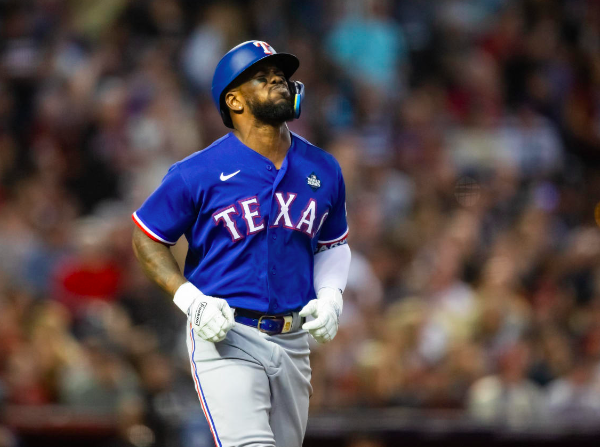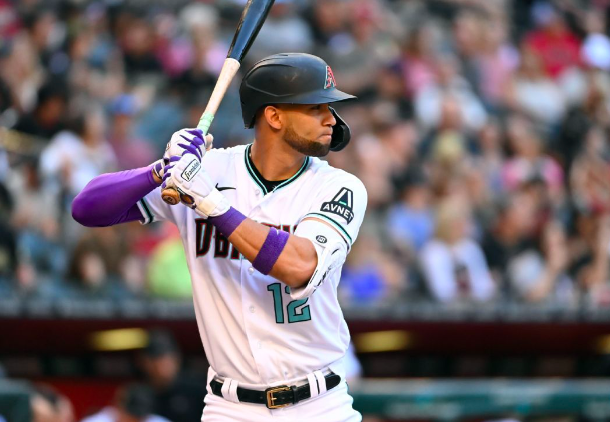It’s the golden hour for Adolis García.
The 30-year-old Cuban professional baseball player and Texas Rangers outfielder has earned his first-ever Gold Glove, an award given annually to the Major League Baseball players judged to have exhibited superior individual fielding performances at each fielding position in both the National League and the American League. Garcia earned the award as a right fielder in the American League.
 While his career-high 39 home runs during the regular season and eight in the postseason made headlines, you can’t overlook García’s tremendous defense in 2023. He earned the award, the fourth by an outfielder in Rangers history, due in particular to his cannon of an arm — his average arm strength of 93 mph. García had a team-best 11 outfield assists this season, which was tied for third in the American League. It was his third straight season with 10-plus outfield assists. He ranked third among qualified MLB right fielders in defensive runs saved (seven).
While his career-high 39 home runs during the regular season and eight in the postseason made headlines, you can’t overlook García’s tremendous defense in 2023. He earned the award, the fourth by an outfielder in Rangers history, due in particular to his cannon of an arm — his average arm strength of 93 mph. García had a team-best 11 outfield assists this season, which was tied for third in the American League. It was his third straight season with 10-plus outfield assists. He ranked third among qualified MLB right fielders in defensive runs saved (seven).
Toronto Blue Jays pitcher José Berríos is also first time winner. The 29-year-old Puerto Rican professional baseball pitcher, known as “La Makina,” managed to bounce back from his worst season in the big leagues in 2022, when he struggled to a 5.23 ERA, to win a Gold Glove.
In ’23, he was more like the Berríos of old, posting a 3.65 ERA over 32 starts. But Toronto also got stellar defense off the mound from the right-hander, who joins Marcus Stroman (2017) and R.A. Dickey (2013) as the only pitchers in franchise history to win a Gold Glove Award.
Another first time winner… Houston Astros utilityman Mauricio Dubón. The 29-year-old Honduran professional baseball utility player appeared at every position on the diamond except pitcher and catcher for Houston in 2023, spending the majority of thetime either at second base or in center field.
He was a slightly below-average hitter, so most of his value came from his defense. Despite spending about half of a season playing second base (616 2/3 innings), he finished with five defensive runs saved at the position and two in the outfield.
Cleveland Guardians second baseman Andrés Giménez won his second consecutive Gold Glove award. The 25-year-old Venezuelan professional baseball shortstop and second baseman led American League second basemen with 18 outs above average and 23 defensive runs saved.
Giménez is the second Cleveland player to win multiple Gold Glove Awards at second base, joining Roberto Alomar, who won three straight from 1999-2001.
Gabriel Moreno has become the first Arizona Diamondbacks catcher to win a Gold Glove award.
The 23-year-old Venezuelan professional baseball catcher led MLB backstops in defensive runs saved (20) and Statcast‘s caught stealing above average (nine) in 2023. And with only 19 Major League games played behind the plate entering the season, only two non-rookies (excluding pitchers) — Ramón Urías (10 games at third base entering 2022) and Pokey Reese (11 games at second base entering 1999) — played in fewer games at the position for which they won the Gold Glove Award. At 23 years and 229 days old, Moreno is the sixth-youngest catcher to win his first Gold Glove honor.
San Diego Padres’ Fernando Tatis Jr. has won his first Gold Glove.
Tatis took home the National League award in right field ahead of finalists Mookie Betts of the Los Angeles Dodgers and Lane Thomas of the Washington Nationals.
When Tatis was moved from shortstop to right field to begin 2023, we wondered how he’d fare out there. He was a revelation defensively, leading MLB with 29 defensive runs saved, and his average arm strength of 96.6 mph trailed only Rockies rookie Nolan Jones in the NL. Tatis’ 24 career games in the outfield before the ’23 campaign were the fourth fewest played at a position for which a non-rookie won a Gold Glove Award.
The Toronto Blue Jays, Texas Rangers and the Chicago Cubs tied for the high among clubs with three winners each, Rawlings announced Sunday.
Berríos, and Giménez earned $50,000 bonuses in their contracts..
Voting was conducted among managers and up to six coaches from each team, who can’t select players on their own club. Since 2013, voting has been factored with a Society for American Baseball Research defensive index, which comprises about 25% of the total.
The utility category is based on a SABR formula and additional defensive statistics.
 The deal also includes an opt-out after the second season.
The deal also includes an opt-out after the second season.
